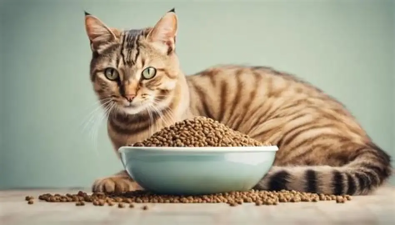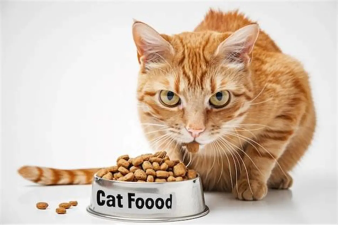1. Best Cat Food for Indoor Cats: Balance Calories and Wellness
Indoor cats lead sedentary lives, making weight management and urinary health critical. Look for formulas that:
Control Calories: Opt for "indoor" or "low-calorie" blends with 30–40% fewer calories than regular food (e.g., Hill's Science Diet Indoor Adult).
Support Urinary Health: Include ingredients like cranberries or omega-3s to prevent crystal formation. Avoid high magnesium levels.
Aid Hairball Control: Added fiber (psyllium, beet pulp) or omega-6 fatty acids (salmon oil) help reduce hairball issues.
Top Pick: Royal Canin Indoor Adult—formulated with optimal calorie density and digestive fiber for indoor lifestyles.

2. Healthiest Cat Food: Prioritize Real Ingredients and AAFCO Standards
The healthiest foods start with high-quality protein as the first ingredient (chicken, turkey, salmon) and minimal fillers. Avoid:
Artificial preservatives (BHA/BHT), colors, or flavors.
By-products (unless specified as "meat by-products," which can be safe).
Excessive carbs (corn, wheat, soy) that offer little nutritional value.
Always check for the AAFCO statement on the label, ensuring the food meets nutritional standards for your cat’s life stage (kitten, adult, senior).
3. Best Cat Food for Senior Cats: Support Aging Bodies
Senior cats (7+ years) need nutrients to combat joint stiffness, boost immunity, and aid digestion. Key ingredients to look for:
Glucosamine & Chondroitin: For joint health (common in Hill's Science Diet Senior and Blue Buffalo Life Protection Senior).
High-Quality Protein: Easily digestible sources like chicken or fish to maintain muscle mass.
Antioxidants: Vitamins C and E (found in Purina Pro Plan Senior) to support immune function.
Expert Tip: Senior cats may prefer softer textures—try wet food or moistened dry kibble if they have dental issues.
4. Dry vs. Wet Cat Food: Pros, Cons, and How to Choose
Dry Cat Food (Kibble)
Pros: Convenient, promotes dental health (crunchy texture), longer shelf life.
Cons: Lower moisture content (risk of dehydration in indoor cats).
Best For: Busy owners; pair with a water fountain to encourage hydration.
Wet Cat Food (Canned/Pouch)
Pros: Higher moisture (aids urinary health), palatable for picky eaters, the closer mimic of a natural carnivorous diet.
Cons: More expensive, shorter shelf life after opening.
Best For: Cats prone to urinary crystals, seniors, or those who dislike dry food.
Optimal Approach: Many vets recommend a mix—dry for convenience and wet for hydration. Brands like Merrick and Wellness offer balanced options in both formats.
5. Consumer Reports’ Top-Rated Brands: Trusted by Experts
Consumer Reports evaluates safety, ingredient quality, and recall history. Here’s their shortlist:
Hill's Science Diet: Consistent AAFCO compliance, tailored formulas for life stages and health conditions.
Blue Buffalo Life Protection: Natural ingredients, no chicken by-product meal or artificial additives.
Royal Canin: Breed- and life stage-specific formulas, highly recommended by veterinarians.
Purina Pro Plan: High protein content, affordable options for active cats.
Always check for recalls on the FDA’s Pet Food Recall List before purchasing.
6. Vitamins for Older Cats: When Supplementation is Necessary
While most senior cats get adequate vitamins from balanced food, some may benefit from supplements:
Omega-3s: For joint and skin health (add a drop of fish oil to food).
Probiotics: To support digestion (look for foods with live cultures, like Wellness Core).
L-Carnitine: To aid weight management in obese seniors (consult your vet first).
Never assume your cat needs vitamins—always ask your vet for a personalized plan.
7. How to Transition Your Cat to New Food
Sudden changes can cause stomach upset. Use this 7-day schedule:
Days 1–2: 75% old food + 25% new food
Days 3–4: 50% old + 50% new
Days 5–6: 25% old + 75% new
Day 7: 100% new food
Monitor for diarrhea or vomiting—if issues persist, switch back and try a different brand.
8. Where to Buy Safe, High-Quality Cat Food
Local Pet Stores: Offer expert advice and often carry premium brands like Orijen or Acana.
Online Retailers: Amazon, Chewy, and Petco offer subscription discounts and home delivery.

Grocery Stores: Convenient for budget options like Iams or Nutro, but check ingredient lists carefully.
Final Checklist: What to Look for on Every Label
✅ First Ingredient: Named protein source (e.g., "chicken," not "poultry by-product").
✅ AAFCO Statement: Confirms it’s complete and balanced for your cat’s age.
✅ No Artificial Additives: Avoid preservatives like BHA, BHT, or ethoxyquin.
✅ Life Stage Match: "Senior," "Indoor," or "Kitten" on the label for tailored nutrition.
By prioritizing your cat’s unique needs—whether they’re a lazy indoor lounger, a golden-aged senior, or a picky eater—you can ensure they thrive on every bite. Start with our recommended brands, consult your vet for personalized advice, and watch your feline friend shine with health and energy!












